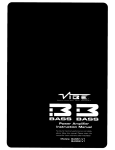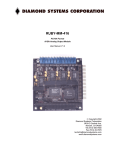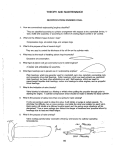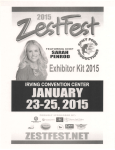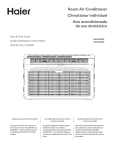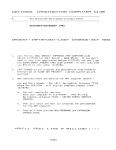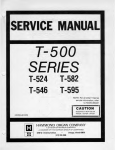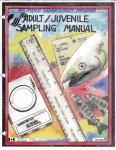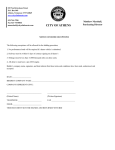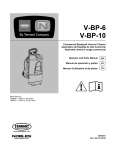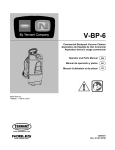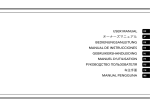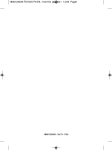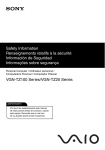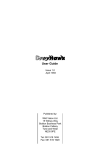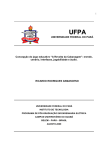Download December 1979 - American Bonanza Society
Transcript
AMERICAN BONANZA SOCIETY
~===-'ttb--
•
=='
NEWSLETTER
Deeember, 1979
Volume 79, No. II
Page 929
RAYTHEON/BEECH AIRCRAFT ANNOUNCE MERGER AGREEMENT
Raytheon Company and Beech Aircraft Corporation jointly announced an agreement in principle to merge on a tax free basis.
The transaction is subject, among other things, to the negotiation of a
definitive merger agreement, approval of agreement by the respective boards of
directors, and by the shareholders of both companies. Consummation of the merger
will be sought at the earliest possible date .
It is planned that Beech will continue to be operated as a separate entity
under its presen t management at its present locations. There will be a separate
board of directors for Beech including appropriate Raytheon representation. It is
also expected that certain Beech executives will join Raytheon ' s board of directors .
Mrs . O. A. Beech, Chairman , and Mr. Frank E. Hedrick, President of Beech,
said, " This merger will provide our company with greater technological depth and
pr oduct developmen t capability to the benefit of our aircraft customers, our
employees, and our stockholders."
•
ACTOR GEORGE KENNEDY TAKES DELIVERY
OF BEECH CRAFT BONANZA A36
Wichita, Kansas -- George Kennedy,
star of all four AIRPORT movies , was in
Wichita recently to take delivery of a
new Beechcraft Bonanza A36 and tour the
Beech Aircraft Corporation ' s production
facilities where his airplane was built.
He will use his new Beechcraft both
in his frequent business travel necessary
to his career and for personal transportation .
Kennedy became a pilot through his
association with the Airport movies and the
r ole he plays in them - the tough, cigarchewing Joe Patroni . It was the real Joe
Patroni, the man on whom the Patroni
character was based , who convinced Kennedy
he should learn to fly 10 years ago. He
has flown many hours since, and curren t ly
holds a private pilot's license with instrument and multi-engine ratings .
"The real Joe Patroni," he said, "is
•
a fellow named Roy Davis, who is head of
maintenance at TWA in Chicago . He's not
a big man , but he chews a cigar like
Patroni and he actual l y did what Pa troni does in the first Airport movie -- gets a
stuck airliner out of the snow. I spent some time with him to get a feel for the
character, and one day when we were having lunch I said ' you know, I ' ve always wanted
December. 1979
Page 930
News and Views
GEORGE KENNEDY (continued)
can afford it, I'm coo old. '
to learn to fly. Now that
He said, 'That ' s no excuse. I ' ve taught people to fly
who are over 70 .' "
Kennedy took Davis' advice, and soon had his pilot's
license .
Discussing his purchase , Kennedy said he chose the
Bcechc ra ft Bonanza A36 because "it has an excellent reputation, it's big, it's fast, it has good range, and it's
easy to f 1)'. "
After his tour of the faccory. Kennedy added that
"Seeing the way Bee ch builds the Bonanza from the inside
out, and the meticulous attention patd to detall makes me
feel extremely sec ure about the airplane. 1 think everybody who buys a Beechcraft would benefit Crom a visit to
the factory to see how Beech puts their product together . "
Kennedy said the Patroni character is identified ....ith
the Airport movies. In the latest one. The Concorde Airport ' 79, Pat rani finds himself piloting the supe r sonic
transport on a trans-Atlantic crossing and beset by people
who don't ....ant the airpla:le to malle it. It d'les, of course,
but only after providing the audience .... ith two hours of
excitement.
"The audien ce knows what ' s going to happen," Kennedy
said . "They come to see it happen. They don 't come to
see George Kennedy. They come to see Joe Patroni."
Kennedy said he enjoys the Patroni charac ter, and
"[ ' II play Joe Patroni as long a8 they ....ant to make Airport
movies . "
'" '" '" '" * AWARD PROGRAM
FAA P[LOT PROFICIENCY
AC 61- 91 describes this program and outlines the eligibility requirements. The effective date for commencement
was July 15. 1979.
Background. In July, 1977, a new pilot safety program
.... as introduced to the public in FAA's Central Region to
cope with rising numbers of general aviation aircraft accidents attributable to pilot error . It was designed to encourage general aviation pilots to avail themselves voluntarily of continuing training. A tie tack or lapel pin and
a certificate of competence were given to those pilots who
completed the p r ogram. Public response has been sufficient
to justify continuing the program and expanding it on a
notional basis.
FAA Regulation Part 61 . 57 requires all pilots to obtain
a flight and oral review with an appropriately-rated flight
instructor once each two years (biennially) in order to act
as pilot in command of an aircraft. The regulation does
not prescribe any minimum flight time for the review nor
docs it specify the maneuvers to be flown. TIle award
program will reinforce the Biennial Flight Review by providing a mini-flight course with minimum instruction times
and selected maneuvers prescribed.
The program wIll be demanding of pilots ' time, critical of their performance, and .... ill provide an excellent opportu nity for them to reevaluate their flight proficiency
and knowledge and, at the same time , earn their wings and
certificate .
Who May Participate. All pilots holding a private
pilot certificate or higher and a current medical certificate may participate . Requests to participate in the program should be made to your local flight instructor, Accident Prevention Program Safety Counselor, or the Flight
Standards or General Aviation Distyict Office .
Training Requirements. Pilots may select the class
and category of aircraft in ....hich they desire to receive
their operational training. All training requirements
must be completed within 120 days after beginning training
under the program. Certain training and flight maneuvers
have been established for airplanes, helicopters and
gliders . For information on these requirements check ....ith
your local FAA office or ask for a copy of AC 61-91 .
Incentive Awards. Upon completion of each of the
three phases of the program , pilots become eligible to
wear snd will be presented a distinctive lapel or tie pin
(wings) and a certificate of completion . There will be no
complimentary wings given . All pilots , regardless of type
of certificate, rstings, or position must earn the right
to wear the Pilot Proficiency Wings .
Intent of the Program. The intent of the Program is
to provide the incentive for pilots to es tabli s h a personal
recurrency training program on a regular basis. Air carriers, the FAA, and the military services require r egular
recurrent training for their pilots to assure that they
maintain a high level of proficiency. Can general aviation
afford anything less? SAFE FLIGHT IS NO ACCIDENT!
,;. '" '" '" *
GENERAL AVIATION AIRWORTHINESS ALERTS
•
Octobe r. 1979
•
AMERICAN BONANZA SOCIETY NEWSLETTER
publJahed by
American Bonanza Society
A New York Non·Profit Corpolallon. Organized January 1187
Publication Office
Reading Municipal Airport , Box 3749, Reading, Pa . 19605
Edllor • William M. Gulnlher
AldenC 8arnc.,Pr......'
1.311 Muirlel'ld. DI'., II JoI... CA 82037
F.1d A. I:IIrt.toI. JI' .• Vice '"'~
I . .A White AodI North een.,. DIII-. Tlt 7lZl11
KMWMIhC Todd. T r _
105 SW Mo.• • PortIInd. OR t721'
A~'h~E~·~~.7t. L..wd••• fL 333"
AleIIarCi O. Endr.
.l5 Orielle W..,.
... ~H. Gor_
M_.-. HJ 01051
P. O. ao. 2Mt. MIn.,iIIcI. OhIo U_
AoWt L. Len,*"- Jf
WI TumIt "CI .• W IlIoomtlllcl . ... I.1033
JIlhnO. """'I"
WOOdI~ L • .• C.mII. IN 4M32
JImeIA. Roberll, Jf
S120 a ••", DI' " Cl>lnInOOg • • TN 37H3
W.MIm .... V• ....,
21~ f.lrdll. Ct. bll.,.. K5 ".0\
307
,.U" £opl'"
""
""
""
""
""
""
""
'"'
19n
'"'
P"'Pr~nft
'H1· II11
'"1 , '173
1I1!lolnS
"'S-II"
" '.· 1177
1117· 11"
"''''"'
Thl AInIrlcIn Bonlnu ~ Newlol«'" II pytllllMd monlhly •• ~ Auglllll I"~
...... ~I by \fItI A",",,", 8011_' 1SodIty" 'lie AIooClIIIQ I,h>f\~,,* AIrIlOf1. 110.
3'''''. ReldIn9. PA 11lI0II The price 01 • r-~ lUblc:rlpllon II Irdud«ll" \fItI IttI'lUII
Cluee (" 5.001 oI8oc11t)' member. S.cond ct"'IXII1Ig. p.'d.t R..Cllno . PA InCl'd·
dlllon.1 fI'III~11\Q offiOl'.
Til. Soe~'Y It\CI Publl.1II< elnnol KC.pt r.. pon.lblll~ 10< till COlflC'nn. 0' K·
Cljfecy 01 lhe m.U ... ""'nlld hI ..ln 01 101 Iny OQlnlon.... p, • • ~ Opln~ 01 'II.
EOIIO< Of conIrlbulOl' dO IlOl
I~ ,.prMenl \fItI POfIIIOII 01 1I\ISoelMy PuDliItlif
_
\fItI rlgMIO "Ied .", ....,.....11U1ln'll1I1d lor publlcllion Copy .uomln~ lor
pUbIc:.tIon
~ 'M proPIttY 01 \fItI SodIlY Ind tIIaIl no! be 'ItUI'nld
PhOnI \2'5)312....7
,.. . . 15US
fOfllIlfl$25US
IS SHOOO3-II1,
til"
Clrcu.,lane.u,
'*....
•
Page 93 1
December. 1979
•
•
COLVIN'S CORNER
ASS TECHNICAL CO~SULT~~T
J. Norman Colvin, world renowned
Bonanza maintenance authority,
Answers YOUR questions;
Conducts ABS Service Clinics.
At the time of his retirement In
1976, Norm was Bonan~a and Baron Project
Service Engineer fo r Beech Aircraft.
PROPELLER . G35
Dear Mr . Colvin:
Our G Hodel Bonanza has developed a strange malady in
recent months . Despite visits to a propeller overhaul
facility and three A&P's ve have been unable to ge t any
satisfactory answers.
The symptoms are, during take off roll ve develop full
manifold pressure, but only 2.100 RPM . The prop seems to
cycle properly, it does go into the flat pitch pOSition, anc
a check of the blade angles with a protractor seems to indicate that everythi llg is A.O.K . with the propeller itself.
The problem is constant and occurs regardless of whether
the automatic prop control is engaged o r not. We have
checked compression and mag timing and those appear to be
normal. We have searched high and low for leaks or blockages on both the intake and exhaust sides of the engine .
Everything performs beautifully on cruise . Our problem seems to be confined to the fact that we are unable to
develop full rated take off horse power .
1 guess what bothers us most is that every attempt at
finding a solution has met with nothing but educated guesses and no one we have been able to find has been familiar
enough with either the engine or the electric prop itself
to come up with any real solid answers . Does our problem
sound familiar to you?
Fred Huber
ABS 15422
Nashua, New Hampshire
Dear Mr. Huber :
There are too many unanswered questions for me to give
you an answer, so I would like answers to the [allowing
questions:
1. Did low RPl-1 for take of[ come on gradually?
2. Was there work of any kind done on the engine and
propeller?
3. What is the manifold pressure at take off?
4. Is low pitch blade angle ll~ degrees r ead at the
33 inch station on the blade?
5 . Is the carburetor alternate air door sp ring
tension good?
6. Does the throttle have full travel?
Try flying the airplane with the induction air filter
removed . One other check : grasp each prop blade tip and
move it forward and aft . You should feel somc looseness
in the blade and hub fit.
If 1 have answers to the above questions, I may be
able to come up with some ideas .
Dear Mr . Huber:
Back in August you wrote Norm Colvin with some
questions about your G Model Bonanza. Norm r epl i ed with
some questions and suggestions .
We wondered if you had a solution to your problem .
Jim Stargel
•
Dear Jim :
Sorry I have not replied to Norm Colvin ' s letter. The
problem has yet to be fully resolved.
After having checked just about everything we could
think of and everything he suggested, we turned the airplane over to a propeller shop who dismantled the o riginal
Beech electric prop and reported that it was "beyond repair"
They had a conversion kit to a Hartzell hydraulic prop and
we decided to bite the bullet and have the change made .
I flew the airplane home and everything seemed to work
quite well with t he exception of a minor oi l leak which was
more of a cosmetic problem than anything e lse. We returned
the ai r plane to have that corrected the following week and
thcn during the fa ll and winter months proceeded to fly it
about 60 hours and got quite satisfactory performance from
the conve rsion. The fine sp ray of oil collec ting on the
windshield pe r sis t ed , and in January we r e turned it sgain
to the same shop for inspection . We flew the airplane home
and during th e 45 minute trip there was no evidence of any
oil leak, and we we re quite pleased with the situation . On
a s hort final at our home airport with powe r cu t back to
about 16 or 17 inches, the bloody thing came unglued and
blew large quantities of oil allover the windshield.
completely obscuring the view from inside the airplane.
The landing was made i n blind faith (more literal than poetic) and fortunately without incident .
For the past six weeks our airplane has been in repose
without propeller, the latter having been confisca ted by the
propeller shop und er the guidance - and very likely e ndless
burden of red tape - or the FAA, and has finally been returned to .Iartzell for inspection.
1.' II let you know how we make out when all is said Bnd
done - if ever . One thing is absolutely certain: Few people. If any . know anything about Beech electric propeller
assemblies. We have a perfectly fine airplane that's been
tied up for eight months and a number of thousands of dollars because or i t. We have learned, at considerable expense, that our e ngine is in very good shape , and we have
avallable for anyone who is interested a very fine Beech
propeller and associated hardware including the automatic
prop co ntrol, and an airplane that won ' t fly no matter how
fast we run the engine. Stay tuned for the next chapter.
We thank the good 1.ord for the American Bonanza Society .
Among a number or othe r good things, it ' s a great shoulder
to cry on .
Dear Jim:
This is further to my letter of March 7th.
We got our pr opelle r back from Hartzell in May and
everythi ng has been running smoothly e ver si nce .
It seems when the original installation was made, the
adapter plate Cor the governor was installed upside down
with the resu lt that the pressu re r el ief port was blanked
off. 1 guess it was just a matter oC time before th e seals
blew and we ' re fortunate that no one was hurt .
We have yet to gain any satisfaction f rom the comp any
that mnde the installation but we came across a guy who
seems to know the Beech electric propeller inside out . He
was delighted t o purchase ou r used unit and declared it to
be in very good shape . He is an ABS member who lives here
in New Hampshi r e , name or John Singer . Members with questions about the electric prop mi ght want to contact him at
some time in the future.
Thank you for your inlerest in our ongoing saga. I
hope it ' s been a great year [or the American Bonanza Society .
Fred I-luber
Editor ' s Note: The ABS member is Dr. John J . Singer , Jr . ,
Box 215. HoUis, New Hamp shire 03049.
The "ongoing saga: " started in July, 1978 , and ended
in May, 1979. We thought our members would be interested
Mr. Huber ' s problems and the solution .
* * PROBLEMS
**
TACTAIR
Dear Mr. Colvin:
1 have a two axis Tactair autopilot (s uction powe r ed) .
It sets up a constant series of right a nd lert turns
thr ough and around the sel ec ted heading . Occasionally it
Simply rel eases for B 40 0 turn before coming back to wobble
around the selected heading .
Any inexpensive ideas, or is this another big bill?
E. G. Southworth
Cleveland, Ohio
Dear Mr. Southworth:
1 know nothing about auto pilots . I would suggest you
contact Av i onics , Inc., Terminal Building, Lunken Airport.
Cincinnati, Ohio 45226 . Telephone 513-871-6221 . 1 understa nd they are the only people who have parts and knowledge
to repair the Tactair autopilot.
* * * '" '"
Page 932
December. 1979
News and Views
WING TIP SPARS - A36
Dear Hr . Colvin:
1 own a Model 36 for which I need both wing tip spars.
The Beech factory has informed us that it would take at
least 4 to 6 months for delivery of these items .
Is it common policy for the fac tory not to stock struc-
tural itees and for it to take this long for delivery?
you know of another sour ce for these spars?
Do
Cha rles E. Jones . N. D. ASS #5941
Fort Stockton, Texas
Dear Dr . Jones:
In o rder to check with the factory in an effort to
speed up part delivery, 1 would need to know the Beech
dealer from whom parts have been or dered. th eir order number
and th e part number.
There are two alternatives .
One is to order the com-
plete wing tip o r the parts separately. Ordering the complete wing tip would not cost a lot more than parts and
lab or to fix your tip . The tip probably would be in stock
and certainly would be shipped In one or two days if ordered AOG by your dealer .
The needed spars also should be ord e red AOG (airplane
on gr ound). AOG parts orde ring costs more but does speed
delivery by taking parts off the production line rather than
from factory parts s t ock .
* * * *- MJ5
LOOSE *VERNIER
Gentlemen :
I have an M Model Bonanza and have the following problem: The vernier knob on lean mixture keeps creeping after
setting. Fortunately it creeps back to "rich".
I have tried to get information locally on what to do
to fix this but I am not able to get an answer. All they
say Is to replace it.
I f this knob cannot be readjusted for friction and the
only answer is to replace it (which is not cheap), then that
is what I will do, but it seems that the problem should be
repai rable.
John Gr evich
ABS 112194
Star Prairie . Wisconsin
Dear Mr . Grevich:
Friction is applied to the mixture control shaft by a
leather washer in one of the nuts that secures the control
to the instrument panel.
To fix, back off on th e back side of th e instrument
panel and tighten the nut on the front side. If the
leather washer is worn out, make a new one by cutting a
piece from one of you r old belts. Chances arc good you
won't need a new washer.
Dear Norm:
t did just what you said . I t took about five minutes
and it worked perfectly without cut ting my belt . I don't
understand why the big Bonanza dealers don ' t know this.
Thanks for the $100 . 00 gift. That ' s what it would
have cost me if I had taken my problem t o a Bonanza dealer.
This pays my dues for the next six years .
John Grevich
**** *
QUESTIONS ON OIL - F33A
Dear Mr. Colvin:
I enjoy reading your commen t s regarding the use and
maintenance of the Bonanza. I have a 1978 F33A and enjoy
it very much. I have 8 few questions:
1. 1 notice a difference in all level between hot and
cold engine. Should the level be measured on a hot or cold
engine?
2. I change the filter with each all change (25
hours) and install 12 quarts. I have not added oil until
it reaches the 10 quart mark on a hot engine . This takes
from 15 to 18 hours. On a cold engine it will read approximately one quart lower . Is this the recommended procedure?
J . I have used an oiled cloth (dripless oil) to wipe
down the prop. Would you prefer thia to waxing the prop?
Frank Newell
ASS #10663
Gresham, Oregon
Dear Mr . Newell:
After the 10-520 engine has been run then shut down,
oil is trapped in the rocker box covers which can trap almost a pint of oil per cylinder . The amount trapped varies
with engines but oil is there in all 10-520 engi nes . This
oil will gradually leak down to give a higher oil level
reading when the engine 1s cold , so it ' s best to check cold
oil.
You have an exceptionally good engine if it only uses
two quarts of oil in 15 to 18 hours . Normally [or local
flights i t is well to carry oil level at ten quarts . For
cross country flight , it is best to start out with twelve
qUArls cold measurement.
Wiping the prop with the oiled cloth is good but I
would prefer that the blades be waxed . Wax will not only
protect the metal f r om corroslon but will make the blades
slicker aerodynamically .
* * * * * . E225-8
HIGH OIL TEMPERATURE
Dear Norm:
I have a C35 with the E225-8 engine.
It had an electric prop and I had a new Hart zell prop and governor kit
installed about a year ago. After the new prop was installed, I have had trouble with the oil temperature going over
the red line in a climb (cowL flaps open) .
Is it possible to put a 225 engine out of a 1964
Debonair in my C35? If so, what would 1 have to do t o get
an STC for it?
William P. Kern ABS 110621
Mishawaka , Indiana
Dear Bill:
Changing the propeller should have nothing to do with
oil temp unless residue in the engine was loosened, whi ch
might clog th e 011 cooler . 1 would suggest the oil tank
cooler be removed and cleaned in acco rd ance with the Beech
Service Manual . While the tank is off . inspect the baffle
inside the tank to be sure that it is secure, and that
there is no hole worn in the baffle by the oil dip stick.
1f thi s work does not correct the trouble, then the
next place to look is the sump pump in the engine . If the
s ump pump is not working properly it won't return oil t o
the coo ler, so high oil temp will occur.
The 1964 Debonair used an IO-470K engine . It will fit
in your Bonanza with engine mount and other modifications .
TIl e hardest job and expense is obtaining STC app roval. I
would sugges t you write or call Lou Stallings , Box 15213,
Tulsa. OK 74112 or phone him at 918-835-7462. He may hold
an STC on such an installation. If not , he mlIy know who
does. If Lou does not know, your local FAA office should
have a li s ting .
My personal opinion is that you would not gain much
by the change.
* * *- *MODEL C
BARON *SEATS
Dear Norman:
I have a 1951 Model C Bonanza and have over the last
three yea rs been updating it. I am now in the process of
designing the interior. 1 want to add the Baron seats to
the front . I intend to keep my rear seat.
I have tried to lo cate a 337 to install the front seats .
I cannot locate one . 1 contacted Cliff Kraemer at Arlington ,
Texas. and he said the 337 was not available In the Southwest . In addition, the FAA will not appove the drilling of
holes in th e main spar unless Beech approves . Beech will
not approve because of product liability.
Can you help in getting my 3J7? 1 understand that the
only difference between my main spar and the later models
1s the holes for the seat track.
Joe H. Beadles ASS #7849
Dallas, Texas
Dear Mr. Beadles:
1 am unable to help you with the STC approval , but 1
note in the ABS Newsletter that Aircraft Paint and Upholste ry, Hangar 3, Lunken Airport, Cincinnati, OH 45226
(telephone 513-321-5576), does do seating changes so most
likely has STC approval or can get it.
•
•
•
December. 1919
•
Page 933
News and Views
STARTER LUBRICATION PROBLEM , V358
Dear Norm:
This will review for you the unfortunate history that
I experienced recently with the starter assembly on my
V)58.
One rainy Saturday afternoon in October, when it came
time to leave the Harlingen Confederate Air Force show . we
were not able to start the plane. As a matter of fact. we
couldn 't even pull the propeller through by hand.
We left it with the people at Air Central on the
•
Harlingen airport . On Monday they called to tell me that
they found the starter adapter assembly frozen from lack of
proper lubrication and the starter burned out . They said
it would be necessary to replace both items. These parts
don't come cheap and the total repair cost approximately
$900.00 .
Since this was the first significant maintenance problem I had encountered In six yea rs of Bonanza flying, I
wasn 't too disturbed. However, I got very disturbed when
exactly the same problem occurred less than s ix hours of
flying time later . Fortunately , this time it occurred at
my home base and 1 was able to become involved with the r epair . With your help and advice , a mechanic found that the
lubrication hole was indeed blocked by carbon deposits .
He cleaned the hole out, put on another new starter housing
adapter assembly , and everything has been working fine .
It is my opinion that the people at Air Central were
negligent in not identifying the problem when they had the
airplane apart , but 1 have about decided that my lega l fees
would cost me mo re than the $900 . 00 1 might ge t back if 1
proved them liable, so at the moment 1 am just accepting
it as a bad break.
In any event, your help was invaluable as always and
1 appreciate your personal interest.
Lawrence W. Hill ABS 14732
Houston , Texas
** * **
FAA ADVISORY CIRCULAR
AC 61-19A
Subject : Safety Hazard Associa ted with Simulated Instrument
Flights and the Use of VieW-Limiting Devices on Aircraft,
AC 61-19A
•
Purpose: This adviSOry circular emphaSizes that a hazard
may exist by rhe use of any device which unduly restricts
or limits the visibility of the safe ty pilot while simula t ed
instrument flight is being conducted.
Cancellation: AC 61-19, Safety Hazard Associated with SiIT.ulated Instrument Flights, dated 12-4-64, and AC 91-17. The
Use of View Limiting Devices on Aircraft, dated 2-20-68,
are cancelled.
Background: Federal Aviation Regulations Section 9l . 2l(b)
Flight Instruction, simulated ins trument flight and cer tain
flight tests, states in part, "No person may operate a
civil aircraft in simulated instrument flight unless (1)
an appropriately rated pilot occupies the other control
seat as safety pilot; (2) the safety pilot ha s adequate
vision forward and to each side of the aircraft, or a competent observer in the aircraft adequately supplements the
vision of the safety pilot; and (3) except in the case of
a lighter-than-air aircraft, that aircraft is equipped with
functioning dual controls."
In some instances , nontransparent mate ri als have been
placed over portions of windshields and windows t o r educe
the possibility of outside visual reference. In certain
instances, these materials may restrict the safe ty pilot's
view and thus introduce a safety hazard that could be unacceptable. Use of such materials may alter the original
aircraft configuration to the extent that the aircraft
could be considered unairworthy. In instances where an
individual has modified the aircraft and is not sure of it s
airworthiness, they should contact the local FAA District
Office for assistance in determining the airworthiness
status.
Recommendation: It is recommended that no material be
placed in the windshields or windows of an aircraft which
will in any way reduce the field of vision of the safety
pilot below what it would be without the presence of such
material.
In addition, sun visors, ai r cr aft curtains, instrument
simula tion slats or other view-limiting devices should be
removed or placed in the retracted position when not actually needed and being used to limit the pilot's outside
reference .
J. A. Ferrarese, Acting Director
Flight Standa rds Service
* * ** *
BRAKES AND BRAKE RESERVOIRS
The "tin can " brake reservoir in old Bonan zas is vented
in a way that can promote water inges tion. The vent hole
is located on the side of th e threaded filler ne ck so that
the reservoi r cap part ially covers the hole. I suspect that
the designer intended the cap to act as a roof t o protect
the vent hole (rom rain. In my straight 35 , this vent
arrangement was causi ng large amount s of water to be drawn
into the sys tem. The raised rim of the reservoir would
allow approximately a teaspoon of rain wate r t o puddle on
the t op . Operating the brakes would suck water through the
ven t hole into the r eservoi r.
1 have found that the Beomet r y of these "tin cans "
va ries from aircraft to aircraf t. In most , the can ' s top
piece i s conical so t hat the vent hole is well above the
rim height and the problem does not exist . A simple check
is to form a puddle of hydraulic fluid on the top of the
ca n. If th e puddle comes up to the bottom of the lid, you
will noti ce that th e puddle can be sucked Into the reservoir
by operating the brakes . By tugging on the reservoi r neck ,
1 was able to form the light stee l top piece to a convex
shape, co rrec ting the problem .
I discovered the moisture problem too late t o prevent
cor rosion of the magnes ium alloy Goodyear wheel cylinders .
The left wheel cyl inder inboard seal start ed leaking fluid
on the brake pucks greatly reducing braking effectiveness .
On disassembly, I discovered extensive co rrosion pitting
in the bottoms of both cy lind e r s . 1 was amazed that the
right wheel was not ye t leaking .
As I recall, new Goodyear castings list at a round
$80, so 1 opted fo r the STC ' d Cleveland conve r sion at
about $500 for the large 700x8 wheels (6S0x8 tires). The
smaller 600x6 Cleveland sys t em is also app r oved and is
what Beech installs on new airc raft today.
CLEVELAND BRAKE PERFORMANCE
The braking action of the big Cleveland s is supurb
with no noticeable fade or sensitivi t y t o mois ture . The
brakes are more sensitive than the Goodyears by perhaps a
factor of 2 or 3 . At fir st this is awkwa rd, but one ge ts
used to it like power brakes in a ca r.
The other major advantage of the Cleve lands is the
long pad and di sc life compa red to the Goodyea r. Changing
pucks and broken disc clips eve r y 150 hours ge ts t o be a
nuisance. 1 understand the Cleveland pads last about 1,000
hours.
The only fault I could find with the Clevelands is
that they tend to drag a little, making it more difficult
to push the aircraft into the hangar. By pushing on each
outboard caliper with my foo t, the drag goes away. The
drag is so sl i ght that I fo r ego this procedu r e if 1 have
assistance pushing.
CLEVELAND INSTALLATION
Installation of the Clevelands is st rai gh tf orward
with the exception of the following caution: The flexible
hoses connect to the calipe r cylinders in a slightly different location than the Goodyears.
It appeared that the hose would d re ss outs ide of the
gear door periphery with the st rut fully exte nded . I
jacked the air craft and slowly raised th e gear . The hoses
were indeed too long and got caugh t i n the door jamb . It
is not a big deal to shorten the hoses.
December, 1979
Page 934
News ,tnd Views
CLEVELAND INSTALLATION (Cont inued)
If you have recently installed
the . following inspection :
(at the spa r cap) one
gea r strut .
~ln g
Clevelands . I recommend
Have an assistant shoulder lift
at a time to fully ex tend the
Then examine the hose dress to assu r e that it
lies well inside of the door pe r iphe r y .
BRAKE SYSTEM FLUSHING
After di scovering my moisture problem , 1 go t in the
habit of draining the brake sys tem at each annual and replenishing with fresh "dry" hydraulic fluid. Unf ortunately,
I would drain the system at the bleed fittings on the wheel
cyl ind ers and these are not at the lo.... e~t point o[ the
cylinder, 80 I was probably l eav ing a puddle of water in
the bottoms of the cylinde r s. There is a 10/37. screw i n
the cylinde r cap plate tbat may have been intended to drain
water from the system.
However, if you are interes ted in saving your Goodyear
brakes from corrosion, I would reconunend removing the "c"
ring r e tained cylinder caps and wiping tbe cylinders cl ean.
I would not be ala r med if you find a s mall amount of corrosion as the "0" ring seal seems ve r y tolerant of surface
r oughness and tb e brakes may function just fine. Refill
the system by upbleeding with freshly purchased hydraulic
fluid . This fluid is designed to absorb moistu r e . A can
that has been sitting around th e hanger with the lid off is
probably al r eady satu r ated with water .
R. C. Keiter
ASS 85686
Airborne Elect r oni cs, Inc.
Healdsburg , California
* '" * *
II:
ASS GROUP INSURANCE : HOW IS IT PERFORMING?
San Antonio , another outstanding ASS meeting. Weather
beautiful - att r active city with ftne facUities - excellent
progr am and arran gement s - many old and new friends - many
questions about the program .
The reason for a group insurance program is to combine
a sizeable group, whi c h year after year has losses lower
than average . This allows the company to pass along premium
savings to the members. The ABS loss r ecord is excellent
and ge tting better. You know how mu ch more all r epai r s
cost today but there has bee n no in c rease in ABS rates for
three years.
What can group insurance do for you if you qualify fo r
the gr oup? First, I be lieve it gives you the broadest
policy currently writte n on ai r craft in this category, including:
1. Valued Form - in event of total loss , you collec t
the face amount of the policy.
2 . Premium Insurance - if the loss should occur the
10th I day , in addition to full se ttlement , 355
days pr emium is returned to you .
3 . There is zero deductible for eithe r in motion
or not in motion losses.
4 . Your company , Republic of Dallas , carries the
highest rating, A+ , fo r financial st r eng th
and claim handling .
5. Prompt courteous service . Sta rt with a toll free
call and we are here to assist in any detail.
Remember, you a r e now part of a valuab le g r oup
of customers, not one swimming alone.
The ASS p rogram has been buildin g fo r nine yea r s . Ask
any participating members what their experie nce has been .
It''s the best way to test any program .
You may not have been elI gible for the prog r am o r for
lowest rates on first inquiry, but now with more Bonanaa
time, try again. Now, or not later than your next renewal
date . ring 1-800-835-267 7 . Say you are an ASS member and
compare for you r self . Don't miss t he boat .
Don Flower
ABS #2852
* * * '"
II:
ASS ANNUAL CONVENTIONS
NASHVILLE , TENNESSEE
July 16-20 , 1980
LAS VEGAS , NEVADA
August 31- September 3, 1981
AFC - HODEL 35
Dear Bill:
I would like to thank you and the others who have co ntributed so much t o the ASS Newsletter. The in [ormation is
always useful and enjoyable readi ng .
I would also like to express my thanks to Norman Colvin
for his encouragement when 1 was trying to make up my mind
on the spar r eplacement in our 35 . He was certainly right .
It is a worthwhile modi fication and 1 would not hesitate to
do it again .
My wife and I own 0703, a straight 35 , at least i t
s tarted that way . It ha s had Lts fai r sha re of modifications . Spa r, M air tips, new panel , a nd many more .
When we bought 3256V it had a little i gnition noise
in the radios. An Alpha 200 and a Mkil made up the radio
stack . Locally the noise wasn ' t too bad, but in the
country it was something else . The mags were overhauled ,
the harness replaced, and a ll the details taken ca r e of .
The result was barely acceptable. Later the radios were
replaced with a pai r of KXl60 ' s and things we re much improved .
Ouring all these happenings another strange thing
would occur . The prop controller wou l d blow an occasional
fuse . Always during start up , o r at least prior to run up.
Afte r replacement the control would work fine. Several
bench checks were made and always showed the same results :
nothing wrong with the controller.
Last yea r the controller got e rrati c and was again
pulled , a nd same as before, worked great on th e bench , bu t
now it was bad in the plane. After a few i n and out cycles
I was determined to find the problem . After much t esting
without any results , l gave up the test equipment and went
after eve ry failure:!. mode that could occur in the power
loops . Eve ntually what should have been obvious wa s discove red : the r otating pole piece was a r ci ng t o the photocell . The indications are clear now. A sagg ing fuse , a
blown fuse when the eng ine sto pped at exactly the right
place , and the sligh t black soot on the edge o[ the rotating pole pieces.
The correction was easy now . Jus t s lid e the photocell
back in its location and tighten the sa fety wire:!. so it will
stay put . I did , and it did . and it works great again .
Best of all , the 19nition noise is all gone, not even a
trace .
Dalton A. Davis ASS U7984
Bell[lower, Californ i a
II:
•
•
****
FLIGHT STANDARDS SERVICE DIFFICULTY REPORTS BE95C55
Found t orque tube attach bracket sepa ratin g from left
elevato t . Suspe c t trim tab flutter .
Part Name : Bracket
Part Condi tion : Sepa r ated
+++++
BE-G33 - Aircraft took off from r ough gravel s trip. Nose
landing gea r would not retract after takeoff . Investi ga t ion
disclosed that rod end , PIN HHL6 , had split in two.
-
GENERAL AVIATION· A!R~OtT1ilNESS ALeRTS
n.fIb>I~"",
*""" 1O_IIO.n
llwI .. IIOo . . . . . . . . .
......
"'''nl
,.
..,..tIft... .....,
l""'._. ,. . ..
_,~ .. '\ ...., . , . . " _ ' _ " " .... lI""'tjo)n"... .....
tIItt _ _ . . . . . . . . . " -II . . .
_ _ '"
II_"'~
_ ..... ' .... il0i0i_'''
".1
___"'''_r.
T-.I ..... ,,_ . _ . _ _ _
'.I~."
t.I ....I"'
.... ' .... hllf.~
::::::::;:~:::,;:..-;:-ftf.."i:"
",alf:WU'-"'..,ut01 It. rioIp _ _ _ IIf ........
.... n ............ _ .... fn<k · .. IOnOotII"" ....
"' ...... KI •• \.. , _ _ .".. Uto buot ....,.............
.......... lIh... _ _ '
<01. . . . _ . . . . . .
......
I ..
4nl-"".
•
December. 1979
•
Page 935
News and Views
[-225 OVERHAUL
Dear SIll:
Here is the letter I promised to write r e my r ecent
experience with exchanging my [-225 e ngine in ou r C-35
Bonanza .
After talking to you last fall , I elected to ge t an
exchange engine from Lou Stallings Airc raft, Tulsa , OK,
with installation by Dee Larsen (local A & P).
My phone
conversations with Lou Stallings were both friendly and
helpful, and I look forward to m~eting Lou in person wh~n
I have the opportunity of going through Tulsa .
•
•
An EGT was installed , strobe installed , electric prop
serviced , and seals between the engine and cowl were r efurbished during installation.
The engine and oil temperatures ran above normal [or
the first 40 minutes at 75% power, at 7 ,000 feet MSL with
the cowl flaps open, during initial flight test. The temperatures then began to drop and after a total of 90 minutes the temperatures were near normal with t he cowl flaps
closed.
I now have about 100 hours on the e ngine and enjoy the
increased performance, The oil consumption rate is ahout
one quart
per six hours, compared to the old engine which
was using one quart per hour.
We had several problems to cor r ect during in s tallat ion
and checkout. First, the fuel pump was assembled backwards
so the engine would start but then immediately quit. Reassembling the pump cor re cted this problem. Seco nd , there
was an oil leak in the sea l between the sump a nd intake
manifold after about 20 hours . This was re sea led. Also
the oil pressure was reading at the low edge of the gr een
arc, so the pump was adjusted to increa se pres s ure by
about 5 psi.
It seems to me I have t o pullout the mixture control
a long way to achieve proper leaning. Using 75% power at
7 , 000 feet HSL t have to pullout the mixture control t o
about 1/4 inch of fuel cut-off before I get any significant
rise in £CT. Also, to get maximum EGT , the mixture control
must be pulled out to the fuel cut- off point. 1 would
appreciate your comment s on this. Editor ' s Note: Not
unusual, believe your ECT.
New door and window seals have been rece ntly installed which reduced the cabin noise over 5 dB. As a re s ult
my radios sound much clearer and ATC does n't comp lain about
poor transmissions. I use the Telex 5x5 headset that 1
won at the Phoenix ASS Convention.
Rollin O. Boe
ASS 18385
Ogden , Utah
* * AIRSPACE
* **
FAA DROPS
PROPOSALS
FAA Administrator Langhorne Bond announced that he
has .... ithdrawn proposed rules for expanding the band of airspace subject to air traffic control and placing more requirements on non-instrument pilots using that airspace.
Bond said the withdrawal of the en route proposals
does not change agency plans to propose new or revised terminal co ntrol areas (TCA), which FAA announced at the time
it issued the en route proposals.
Bond said his decision to withdraw the en route proposals came after FAA's review of ex t ensive publi c comment
on the proposals and analysis of othe r related data and
information indicated there may be more effective alternatives for achieving the agency's safety objective.
FAA received more than 43,000 comments on its proposed " Controlled Visual Flight" rules to help reduce the
threat of midair collisions. Bond said he was impressed by
the quality and thoroughness of the recommendations received
from the public and he said they will provide a valuable
data source for future analysis .
Specifically, FAA has dropped its pr oposal to lower
the floo r of positive control airspace from 18,000 feet to
12,500 or 10,000 feet (depending on lo cat i on) . TIle proposal also would have required pilots operating under visual
flight rules (VFR) to file flight plans, maintain communications with air traffic control, and adhere to air traffic
control clearances and instructions when ope rating between
12 , 500 feet (or 10,000 feet) and 18 , 000 feet. Cu rre ntly.
only instrument flight rule (lFR) ope rations are required
t o be subject to air traffic control in th e airspace between 10,000 feet and 18,000 feet .
** ** *
ABS FLIGHT INSTRUCTOR REFERRAL
Dear
I~Ul:
Thanks for sending me th e addresses and phone numbers
of the instructo rs ....ho took the Long Beach Semina r. My
biennial was due fo r renewal. 1 also wanted to do some
in s trument r ef resher work.
I chose to call one of the instructors living in my
area, James R. Croollls . I explained to him that I had rece ived his phone numbe r from ASS, and that I needed to do
some Instrument refre s her work and take a BFR. He asked me
my hours, rating, and model of aircraft. We met at the Long
Seach Airport the following Sunday .
After checking my logbo ok , license and medical, he told
me he had been flying since 1937 . I fiew w ~ him 7 hours.
Jim is a very thorough in s tructor and he knows Bonanzas . 1
intend to use more of his flying knowhow in the future .
1 enjoyed the San Antonio Convention very much.
Bud Lambeth
ABS '250
Downey, California
A NOTE FROM DON BICLER
Mr . James E. Stargel
Associate Director
Dear Jim:
We are in the process of puttin g things back together
at TCM . but it will be 8 while before everything is normal
again.
Jim . I am sorry that circumstances prevented me from
at tending the meeting. and while I know you were inconvenienced 1n having to obtain another speaker. 1 trust all
went well for you.
Thank you for your concern and thoughts .
Sincerely .
Don Bigler, Presi dent
Teledyne Continental Motors
* * * * ALERTS
*
GENERAL AVIATION AIRWORTHINESS
October , 1979
Beech 95-AS5
Drag Link Attach Fitting
An investigation to determine why the nose gear doors
were not closing disclosed the right drag line fitting had
severely eroded. TIle battery drain hose was not positioned
properly which allowed venting of the battery ont'o ['he fitting. The fitting was repla ced and the battery vent hose
was secured in the proper position. Total aircraft time 2 . 740 hOUTS.
* * ** *
Vacuum Pump Precautions
A potentially hazardous condition exists on all light
aircraft using dry air pumps manufactured by Airborne
Manufacturing Company .
Tests condu cted indicate a deficiency 1n the shaft seal
design , and that engine cleaning procedures. normally associated with routine annual and/or 100-hour inspections. may
cause harmful agents such as Stodda rd solven t to be ing!sted and cause premature failure . Because solvents of th~8
type rapidly attack the carbon bearing, vanes and r otor
used in this type of pump, the failure ca n take place quickly and with little or no warning. To prevent such occurrences, the following protective actions are recommended
when cleaning aircraft engines :
1. Carefully cover the coupling area between the pump
and the e ngine drive shaft so that no cleaning soivent can
reach the coupling or seal.
2. Replace the vacuum relief valve filter after cleaning the equipment in the e ngine compartment BEFORE star ting
the engine .
These precautions a r e particularly applicable to single en gine aircraft ....here no backup vacuum supply is available.
** * **
•
BONANZA OF TIl E ,.lONTH
I have been meaning to write and submit my Bonanza as
a candidate for " Bonanza of the Month" for some time. I
neve r seemed to ge t my act t ogether . but finally . here it
is.
The extensive modifications to N1990D. 1952 C Model
03230 include:
Cleveland Baron brakes , Be r yl oil separato r, single
piece windshield. Hartzell propeller . custom interior ,
imron paint , E- 225 engine, oxygen system , stereo casette
sys t em , late style overhead vent sys tem and control wheel,
new extended nose wheel doors, and high speed gear kit.
Perhaps the most s ignificant mods are concerned with
th e custom instrument panel .... ith Bendix avionics (see the
photo) .
Other modifications include the complete re ....ire of the
panel, all new re set t ype CB ' s (easily accessible under the
r adio stock) , throttle, prop, mixture cont r ol , Bendix key
s tarter, 3" non tumble gy ros, Beech panel kit , Beech flap
and gear swi t ches, dual strobes, 3 fuel gages, voltmeter,
EGT, pitot heater, built in push to talk/Plantronics headset . late style heater, carb heat, knobs . All indicator
lights are "iris " t ype - push to test. All engine gages
are individual 2J.c" gages.
Engine Hount
GENERAL AVIATION AIRWORTHINESS ALERT
1-lodels 95. B95. B95A. D95A and E95
Numerou s reports
of cracks found in the
tubular engine mounts
of these airc r aft have
been received. Beech
re commends the engine
mounts be inspected
with at least a 4-power
magnifying glass eve r y
100 hours time in service This inspection
is s pecified in Beech
Class II Se r vice Inst ru ctions No. 0816-241.
A broken mount was found when a clamp was removed for
relocatipn during a laO-hour inspection. The break was
covered by the clamp.
These engine mounts are not heat treated; the re for e ,
if c racks are found during this inspection, repa irs can be
made using the guidelines contained in the welding sect i on
of FAA Advisory Circular 43.l3-1A.
'* '* 'Il INSTRUCTOR
'*
ANOTHER SUCCESSFUL *FLIGHT
SEMINAR
The Oak Brook Hyatt House in Chicago was the scene of
the third Bonanza Oriented Advanced Flight Ins tructor
Refresher Seminar, October 26 - 28.
Those attending ran ged from members bringing their
flight instructors to 747 captains. Comment s from the
attendee~ were most gra tifying .
Many instructors commented "best eve r".
Members desiring a list of graduates may contact ABS
headquarters.
•
BONANZA ORIENTED FLIGHT INSTRUCTOR
RECERTIFICATION SEMINARS
1980
January 18-20
'Wichi ta, Kansas
Feb rua ry 15-17
Atlantic City , New Jersey
March 14-16
Fort Lauderdale, Florida
May 16-18
Long Beach, California
May 23-25
Palo Alto, California
Septembe r 12-14
Denver, Colorado
October 17-19
Chicago, Illinois
BONANZA SERVICE CLINICS
The 1980 Service Clinic schedule will be printed when
completed .
C A L
The engine conversion (185-11 to E-225) wa s done by
Pete Wolf, now the co-owner of Fresno Flight Services at
Fresno, CA . The major sheetmetal work on the extensive
panel mods was done by Jim Schmidt , now the shop manage r
at Fresno Flight Services. These two gen tlemen are real
craftsmen and I can heartily recommend their work.
I have owned 900 for 12 yea r s and have flown it approximately 3 , 000 hours. It is a fantastic aircraf t and is a
real member of the family. A lot of blood, sweat and tear s
have gone into the aircraft, and we are very proud of it.
Keep up the good work.
Michael R. Wash ABS #4683
San Jose, California
II II II II
*
Februa!1 2-16 . 1980
Contact Harry Hadler
405-223-1465
AEril 4-6
Contac t Harry Hadler
A2r11 3-6
Contact Bill Norwood
704-225-0013
Ma~ 16-18
Contact Richard Kull
609-983-6060
Jull 12-16
Contact Harry Hadler
END A R
SOUTHWEST CHAPTER
Winter Holiday
Innisbrook, Florida
and
Treasure Cay, Abaca, Bahamas
SOUTHWEST CHAPTER FLY-IN
Natchez Vicksburg, MS
SOUTHEAST CHAPTER FLY-IN
Charleston, SC
NORTHEAST CHAPTER FLY-IN
New Je r sey Shore
SOUTHWEST CHAPTER PREDayton , OH
CONVENTION TOUR
and Washington, DC
-
•








